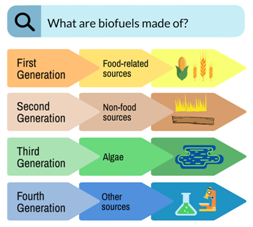Why in the News? A team of scientists from Assam and Odisha in India, China, and the U.K. has developed a water-repellent catalyst that can cut the cost of producing biodiesel substantially from the current levels.
What’s in Today’s Article?
- About Biofuel (Definition, Purpose, Types of Biofuels)
- India’s Biofuel Policy
- News Summary
About Biofuel:
- Biofuel is a fuel that is produced over a short time span from biomass, rather than by the very slow natural processes involved in the formation of fossil fuels, such as oil.
- Since biomass can be used as a fuel directly (e.g., wood logs), some people use the words biomass and biofuel interchangeably.
- However, the word biofuel is usually reserved for liquid or gaseous fuels, used for transportation.
- Most of biofuel consumption occurs as a blend with refined petroleum products such as gasoline, diesel fuel, heating oil, and kerosene-type jet fuel.
- However, some biofuels do not require blending with their petroleum counterparts and are referred to as drop-in biofuels.
- The most common biofuels now are:
- Bioalcohols such as ethanol, propanol, and butanol (a substitute for petrol/gasoline);
- Biodiesel (a substitute for diesel);
- Bio-oils (substitutes for kerosene).
Generations of Biofuel:

- Biofuels are also divided into four categories depending on their origin and production technologies.
- First Generation:
- 1G biofuels are produced from consumable food items containing starch (rice and wheat) and sugar (beets and sugarcane) for bioalcohols, or vegetable oils for biodiesel.
- However, the yields of 1G biofuels are low and can have negative impacts on food security.
- Second Generation:
- 2G biofuels are mainly obtained from non-food feedstocks such as forest/industry/agricultural wastes and waste or used vegetable oils.
- Third Generation:
- 3G biofuels, known as ‘algae fuel’, are derived from algae in the form of both, biodiesel and bioalcohols.
- Although the yield of 3G biofuels is approximately 10 times higher than 2G biofuels, producing adequate algal biomass and scaling up extraction techniques are as yet unresolved challenges.
- Fourth Generation:
- Like the third generation, 4G biofuels are made using non-arable land.
- However, unlike the third, they do not need the destruction of biomass.
- This class of biofuels includes electro fuels and photo-biological solar fuels.
India’s Biofuel Policy:
- In 2021-22, the Central government amended the Biofuel Policy (2018) to set a target of country-wide blending rates of 20% ethanol and 5% biodiesel by 2025.
- According to the Roadmap for ethanol blending in India 2020-2025 report from NITI Aayog, India will need to increase ethanol production capacity from the expected 3.3 billion liters (in 2020–2021) to at least 10.2 billion liters (5.5 billion liters from sugarcane and 4.7 billion liters from grains) by 2025.
- Supported by these policies, ethanol for blending in gasoline production and demand nearly tripled between 2018 and 2023 and now stands at near 12% (7% on an energy basis).
- Sugar cane provides most ethanol production with the remainder from food grains such as maize and surplus rice stocks determined by the Food Corporation of India.
Catalyst to Produce Cheaper Biofuel:
- A collaborative team of scientists from India, China, and the U.K. has developed a water-repellent catalyst that significantly reduces the cost of producing biodiesel.
- This innovative "spherical superhydrophobic activated carbon catalyst" is designed to withstand water byproducts generated during biodiesel production, mimicking the natural water-repelling properties of surfaces like lotus leaves.
- Currently, biodiesel production costs about ₹100 per liter in India, but the new catalyst could reduce this significantly.









